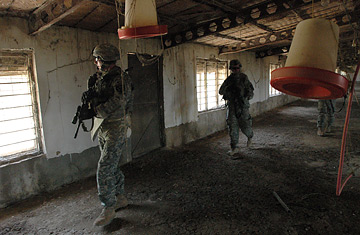
U.S. soldiers search an abandoned chicken farm during a mission near Baquba, Iraq.
The thunderous start of Operation Arrowhead Ripper in Diyala province inaugurates the second phase of Gen. David Petraeus's "surge" strategy. If the first, a massive security crackdown in and around Baghdad, was designed to smoke al-Qaeda and other militant groups out of their foxholes, the new assault is meant to pick them off in open battle. The assault began in and around Baquba, the volatile provincial capital about 31 miles northeast of Baghdad, and involves over 10,000 American soldiers and heavy air cover.
It may be several days or weeks before we know if Arrowhead Ripper lives up to its name, but it's already clear that Petreaus is pursuing a very different offensive strategy from his predecessors.
Until now, major U.S. military offensives against Sunni militants have tended to be big set-pieces — Fallujah, Tal-Afar, Al-Qaim. Each of these operations had a long buildup, giving groups like al-Qaeda plenty of time to move their key commanders and fighters out of harm's way, leaving behind a small corps of jihadis to engage the Americans. And when the operation began, the military concentrated its energies on a single location, allowing the militants to pop up in other, relatively unprotected places.
Operation Arrowhead Ripper has been much quicker off the mark — although any offensive that requires the buildup of 10,000 soldiers can hardly be lightning-fast. But more important, it is accompanied by a second, flanking operation south of Baghdad. Over the weekend, elements of the 3rd Infanty Division began sweeping through militant-infested areas like Salman Pak and Arab Jabour. This means the militants facing the American forces in Diyala can't run south for cover. (Even farther south, British and Iraqi security forces have been conducting raids against Shi'ite militias, especially the Mahdi Army, in around the city of Amarah.)
Will Petraeus' plan work? The ferocity of his fighting force — and of his own resolve — is not in doubt. Nor is there any question that al-Qaeda is at large in Diyala. The province, northeast of Baghdad, has become the main hideout of jihadi fighters driven out from the Iraqi capital and from Anbar province. U.S. forces there have had almost daily encounters with al-Qaeda amid the orange groves that line the Euphrates valley south of Baqouba.
But as the man who wrote the book — literally — on modern counterinsurgency tactics, Petraeus knows such operations stand or fall on the quality of the intelligence: you have to know exactly where the enemy is hiding. This is where Petreaus' predecessors have often been found wanting. Poor intel was the main reason the last major military offensive against Sunni militants ended in a huge embarrassment: Operation Swarmer in March 2006 was billed as the biggest air offensive since the end of the war, but netted only a handful of low-value insurgents.
Arrowhead Ripper has got off to a more positive start. In early fighting, the U.S. forces reported they had killed at least 22 insurgents. And the flanking operation south of Baghdad is already in full swing. The big test ahead is whether Petraeus has plugged all the possible holes to prevent al-Qaeda fighters from slipping away again.
